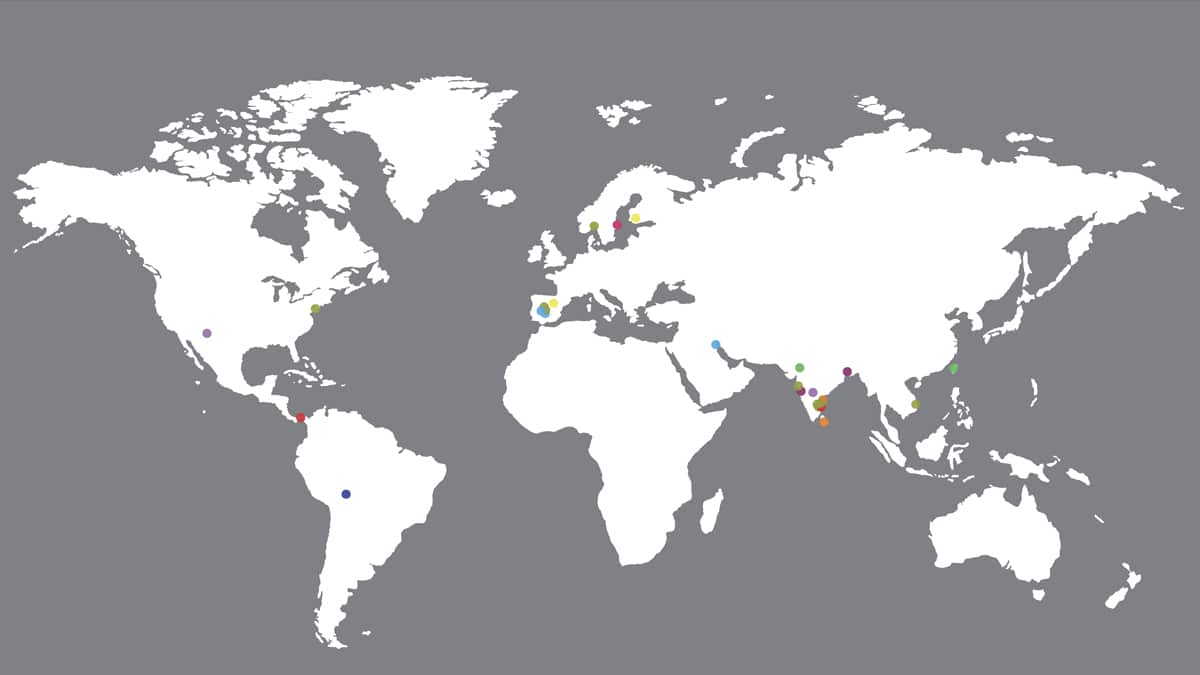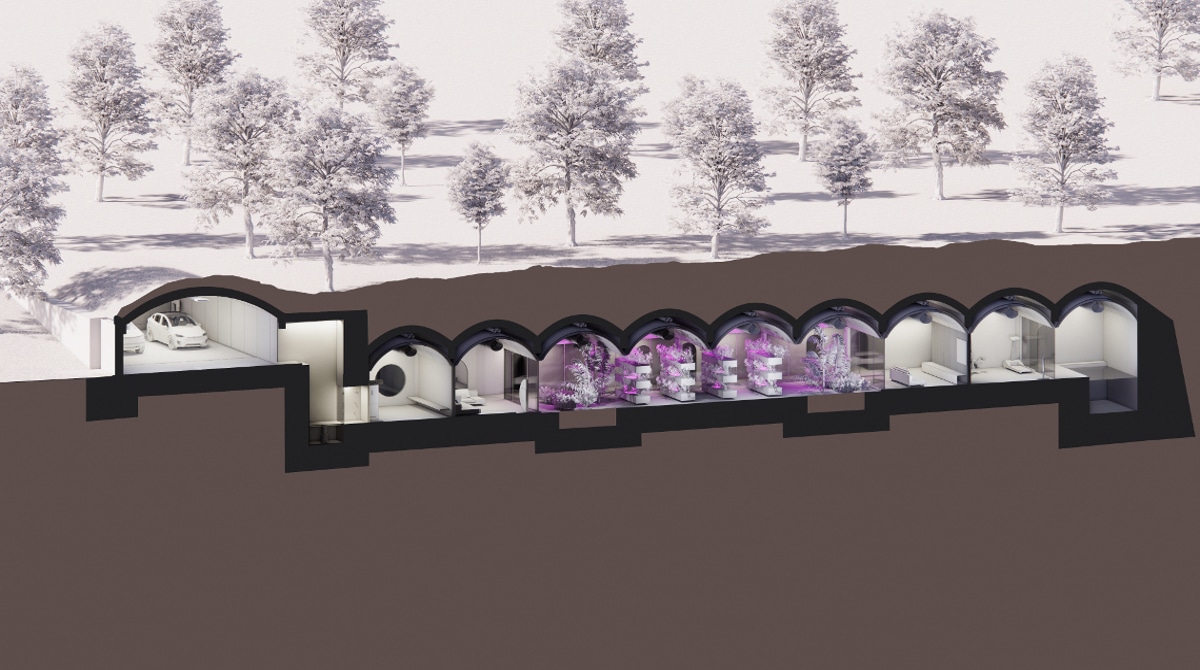Para español, leer debajo de las imágenes…
International Expansion in Architecture, by Alfredo Munoz
“Internationalization” seems to be the buzzword in the Spanish architectural community of the moment. The harsh reality of the economic crisis has forced many architects to look abroad as the only way to survive. The architectural “journey” has left behind its intellectual and formative connotation to become true nomadism, where the survival of an entire generation of architects depends on its success.
In my case, since early in life, I was influenced by the “architectural journey” on the work of Wright, Le Corbusier, Khan, Barragan or Utzon, so I decided to start my discovery at the age of 23. The destiny wanted that this introspective quest would become the learning of the tools of “global nomadism”.
Today, after 11 years of living and working on four continents, and thanks to those learnings, I have been able to have ABIBOO Studio designing projects across the globe in the four years of the life of the firm.
In the lines that follow, I will share some of the tools that have worked for ABIBOO’s team. These tools might not be the best way to succeed in internalizing architectural services and it is not an easy path… Indeed it is closer to pain than to pleasure, so those who are looking for the easy way to achieve internationalization, I am sorry to communicate that I am clueless about how to achieve it.
Firstly I would like to clarify two different paths of approaching internationalization: the “front-end” and the “back-end”. In my opinion, both are necessary for the success of a global initiative.
The first component of internationalization is the “front-end”, i.e. the marketing and “sales”. This component is the most obvious to achieve exports (having clients outside the borders from which one operates).
The world has become flat and with it the option of providing services to various countries. However, this opportunity to operate on a global scale contradicts another reality: people are social and emotional animals. Consequently, human relationships, even in the technological and digital era, continue to be the fundamental criteria for decision-making. In the real estate sector, this is even more so, as trust between architect and client is a necessary prerequisite for any collaboration: the amounts of capital associated with projects are too high to be entrusted to an “unknown”.
Therefore, the physical and frequent presence in each of the places where one seeks to work is fundamental. I do not consider it possible to export without the existence of a reliable representative establishing and maintaining the relationships that can give rise to interesting architectural projects.
As an example, ABIBOO Studio currently has offices in Madrid, New York, and Chennai. However, ABIBOO’s “front-end” is also in Kuwait, Taiwan, and Panama. We achieve this opportunity through the presence of people of total trust who are in charge of mobilizing these relationships. We are also currently establishing strategic alliances in Vietnam and Ecuador to increase this international presence through partnership models with local teams. In ABIBOO, we also know that not all the countries where we are will be successful. From my point of view, accepting failure as a tool for internationalization is necessary.
The long-term success of architectural export requires the establishment of quality relationships at the local level. For this, I believe it is essential to be able to motivate teams and individuals in different countries and cultures that share the same vision of architecture.
The “front-end” is the visible face of internationalization. However, the hidden side of the term is the “back-end”, and it corresponds to the actual operational component. Both sides are inseparable parts of the coin, and ensuring proper coordination between them is fundamental.
Thomas L. Friedman (“The World is Flat”) expanded in 2005 on the idea of working satellites located in various countries that are geographically distant from each other. According to Friedman, “outsourcing-offshoring” makes it possible to reduce costs and increase the speed and efficiency of resources, while democratizing society by rebalancing global economies and flattening the political-economic map of the world.
The author also suggests that this delocalization of the production is not optional but a must for success. The flattening of the world now allows a greater number of individuals scattered around the planet to perform the same job, and therefore it is necessary to respond with greater speed and at more competitive solutions, which is unattainable without resorting to such forms of work.
The global world offers many opportunities that are necessary to meet the new needs and that are increasingly difficult to cover if they are not synchronized. In the field of architecture, Anglo-Saxon technical rigor is difficult to match in the world; neither is European or Japanese architectural sensitivity; Chinese or Indian production capacity; Latin American creativity; or Southeast Asian interpersonal skills. They are all values that combined ensure a solid, committed team with the best capabilities to respond to the requirements of any culture and any location.
I think once the proper infrastructure and global team are in place, an architectural company can start exporting their services, and not before. The opposite is the biggest mistake that many contemporary architects make. Those who try to reproduce a classic work model in the new modernity will probably end up exhausted before achieving adequate internationalization.
From my humble point of view, it is the concept of the “back-end” the great secret of the current success in the internationalization of architecture. I believe that the international structure must exist before looking for projects at a global level. In this sense, although ABIBOO Studio only has direct operations in the USA, Spain, and India, our “back-end” also expands to Panama, Uruguay, and China, covering the talent of six different countries. While keeping the focus on innovation, this operational structure allows us to be able to reduce costs and delivery schedules, since we can work almost 24 hours a day thanks to time zones. By doing so, we can take on large-scale projects in emerging countries such as China or India.
Remote work, virtual communication, process-based creativity, and the environment to generate ideas by multicultural teams are changing the way architecture is designed as well as relationship management with clients, consultants, and local collaborators. These ways of working are those that allow a cohesion between the “front-end” and the “back-end”, between the local reality and the global vision.
I visualize the architectural office of the future as completely atomized, like a cloud with sub-nodes of both commercial and operational activities. Nodes that are distributed in different places but working with a great deal of coordination between them. For the proper implementation, it is essential to have a clear and ambitious vision, as well as simple and bold creative processes that respond to the current social needs, which are increasingly complex and in permanent change.

Expansión Internacional Arquitectónica, según Alfredo Muñoz
“Internacionalización” parece ser la palabra de moda en la disciplina arquitectónica española del momento. La cruda realidad de la crisis económica nos ha obligado a muchos arquitectos a mirar al exterior como única vía para la supervivencia. “El viaje” arquitectónico ha dejado atrás su connotación intelectual y formativa para convertirse en un verdadero nomadismo, en donde de su éxito depende la supervivencia de toda una generación de arquitectos.
En mi caso, desde joven quedé fascinado por la influencia del “viaje arquitectónico” en la obra de Wright, Le Corbusier, Khan, Barragan o Utzon por lo que decidí iniciar mi propio camino hacia el extranjero a la edad de 23 años. El destino quiso que dicho viaje introspectivo se convirtiera en el aprendizaje de las herramientas de un “nomadismo global”.
Tras 11 años viviendo y trabajando en cuatro continentes, y gracias a esos aprendizajes estoy pudiendo lograr que ABIBOO Studio tenga proyectos a nivel global, tras únicamente cuatro años de haber fundado la firma.
A continuación, compartiré algunas de las herramientas que han funcionado equipo de ABIBOO. Estas estrategias no tieen porque ser el mejor camino hacia la internacionalización, y de hecho están más cerca del calvario que del placer. Por ello, para aquellos que busquen la vía fácil para lograr la internacionalización, siento comunicar que soy un total desconocido de cómo lograrlo.
Para comenzar, me gustaría clarificar dos componentes de la internacionalización: el “front-end” y el “back-end”. Ambas creo que son necesarias para el éxito de una iniciativa de envergadura global.
El primer componente de la internacionalización es el “front-end’, es decir el componente marketing y las “ventas”. Este componente es el mas obvio para lograr exportar (lograr proyectos fuera de las fronteras desde donde se opera).
El mundo se ha convertido en plano y con ello la opción de aportar servicios a diversos países. Esta supuesta oportunidad para operar a escala global se contradice con otra realidad: el hombre/mujer es un animal social y emocional. Como consecuencia, las relaciones humanas, en plena era tecnológica y digital, siguen siendo la base fundamental en la toma de decisiones. En el sector inmobiliario esto ocurre aún de forma más acentuada ya que la confianza entre arquitecto y cliente es algo necesario previamente a cualquier colaboración: las cantidades de capital asociadas con los proyectos son demasiado elevadas como para confiárselas a un “desconocido”.
Por ello la presencia física y frecuente en todos y cada uno de los lugares donde se busca trabajar es fundamental. No considero posible lograr exportar sin la existencia de una figura de confianza estableciendo y manteniendo las relaciones que pueden dar lugar a proyectos arquitectónicos de interés.
Como ejemplo, ABIBOO Studio cuenta actualmente con oficinas en Madrid, Nueva York y Chennai. Sin embargo, el “front-end” de ABIBOO está además en Kuwait, Taiwan y Panamá. Esta oportunidad la logramos mediante la presencia de personas de total confianza que se encargan de movilizar dichas relaciones. Igualmente estamos actualmente estableciendo alianzas estratégicas en Vietnam y Ecuador con el fin de aumentar dicha presencia internacional mediante modelos de asociación con equipos locales. En ABIBOO también sabemos que no todos los países donde estamos van a ser exitosos. Desde mi punto de vista, aceptar el fracaso como herramienta para la internacionalización es necesario.
Para el éxito prolongado de la exportación de arquitectura es necesario establecer relaciones de calidad a nivel local. Para ello creo fundamental ser capaz de ilusionar equipos y personas en diferentes países y culturas que compartan la visión sobre la arquitectura.
El “front-end” es la cara visible de la internacionalización. Sin embargo, la cara oculta del término es el “back-end” y que corresponde con el componente propiamente operacional. Ambas caras son partes indisociables de la moneda y asegurarse una correcta coordinación entre ambas es fundamental.
Thomas L. Friedman (“The World is Flat”) recoge ya en 2005 la idea de satélites de trabajo localizados en diversos países distanciados geográficamente entre sí. Según Friedman, el “outsourcing-offshoring” permite reducir costes y aumentar la velocidad y eficacia en la gestión de los recursos productivos, al tiempo que democratiza la sociedad reequilibrando las económicas globales y aplanando el mapa político-económico del mundo.
El autor también sugiere que esta realidad de deslocalización productiva no es opcional sino obligatoria para el éxito. Este proceso de aplanamiento del mundo permite ahora que un mayor número de individuos repartidos por el mundo pueda realizar el mismo trabajo, y por tanto es necesario responder con mayor velocidad y a menor precio, algo que es inalcanzable sin recurrir a dichas formas de trabajo.
El mundo global ofrece muchas características que son necesarias para satisfacer las nuevas necesidades y que cada vez son más difíciles de cubrir si no están sincronizadas. En el campo arquitectónico, el rigor técnico anglosajón es difícilmente igualable en el mundo; tampoco lo es la sensibilidad y formación arquitectónica europea o japonesa; la capacidad de producción china o india; la cercanía cultural y creatividad latinoamericana; o la habilidad interpersonal del sudeste asiático, son todos valores que combinados aseguran un equipo sólido, comprometido y con las mejores capacidades de dar respuesta a los requerimientos de cualquier cultura, y de cualquier localización.
Una vez con la infraestructura y el equipo global adecuado es cuando puede darse el salto a la internacionalización en el “front-end”, y no antes. Es aquí el mayor error que cometen muchos arquitectos coetáneos… Aquellos que intentan reproducir un modelo de trabajo clásico en una nueva modernidad están, desde mi punto de vista, destinados a acabar exhaustos antes de lograr una adecuada internacionalización.
Desde mi humilde opinión, es el concepto del “back-end” y no el del “front-end” el gran secreto del éxito actual en la internacionalización de la arquitectura. Creo que la estructura internacional debe existir antes de buscar proyectos a nivel global. En este sentido, aunque ABIBOO Studio cuenta solo con operaciones directas en USA, España e India, nuestro “back-end” también se expande a Panamá, Uruguay y China abarcando el talento de seis países diferentes. Esto nos permite, manteniendo el enfoque en la innovación, ser capaces de reducir costes y plazos de entrega, ya que podemos trabajar casi 24 horas al día debido a los cambios horarios, algo que es muy importante en proyectos de gran escala en países emergentes como es el caso de China o India.
Las formas de trabajo remoto, de comunicación virtual, de creatividad basada en procesos, y el ambiente adecuado de generación de ideas por equipos multiculturales remotos están cambiando la forma de diseñar arquitectura, de gestionar las relaciones con clientes, consultores y equipos de colaboradores locales. Estas formas de trabajo son las que permiten una cohesión entre el “front-end” y el “back-end”, entre la realidad local y la visión global.
Yo imagino la oficina de arquitectura del futuro completamente atomizada, como una nube con sub-nodos tanto de actividad comercial como operacional, que están distribuidos por diferentes lugares, pero funcionando con un gran engranaje y coordinación entre ellos. Para lograr dicha cohesión es fundamental contar con una visión clara y ambiciosa y unos procesos creativos sencillos y audaces que den respuesta a necesidades sociales actuales, cada vez más complejas y cambiantes.







